Glen Snow – 17 January, 2013
We can only see her as a full frontal from groin to foot, standing at some riverbank while confronting us with her genitals. This painting has one of those lurid pink grounds, which serve also as the nude's flesh. The fact that we see her form at all is due to the daubs of grass-forming green that frames what become her legs and pelvis. The implication is that the pink-ground beneath all this verdant paint is her skin like some sort of omnipresent womb.
Ozlyn, in its squeezed location, manages to open a deceptively capacious interior for the mind of any K’ Road wanderer. In its final exhibition of 2012, with the work of Elisabeth Hyde-Hills, such a mental landscape was opened with the nine small paintings she grouped under the title of Claude Glass. The title suggests immediately her own possible travels, like those of the seventeenth century romantic types who took these slightly convex ‘black mirrors‘ with them to help frame the imposing mix of beauty and sublime they sought in Nature. Such mirrors had the effect of isolating particular scenes from overwhelming views and surroundings, and reducing tonal values and hues, so as to be more easily translated into paint. Notions of the picturesque were born in such dark mirrors.
A way of seeing seems also to be suggested by Hyde-Hills’ painting, and while she is certainly looking at landscape, these are not from any touring of natural sights. The picturesque painters would have been horrified to count her among their number, but then she seems only to look over her shoulder at the nature they depicted, to say it is all a matter of perspective: a convex and dimmed perspective at that. Her work is after all no less a fabrication than theirs was. As if to offer a rejoinder her Claude glass seems not so darkly tinted, as ground in some kind of lurid Rose quartz. The paintings make a play at softness, with their pastel colours, but there is something violent in that pink or yellow, which underpins some of this painting. Her brushes are small, with tiny gestures of the fingers often gathering little daubs into colour fields. The paint is semi-transparent in places, so that a type of glazing adds to a quality of lightness in the touch, and the layers, back to the brightly coloured grounds of her surface, can be read.
These landscapes are unnatural, and speak more to dreams where she seems to be whispering some beautiful lie. Hyde-Hills is very deliberate in her framing of this work: instead of a clarifying statement, the show is accompanied by another work, a poem, as if to return us to the romantic sensibilities of the seventeenth and eighteenth-century mind that originally made use of the Claude glass. The poem, by Rebecca Boswell, begins, ‘A figure lies here / Thrice removed, she is still / The agent of it all‘. And so she seems to turn our attention to one of the paintings, more like a sketch, which remains hidden from the initial view of the other eight works. It is one of only two paintings which includes a figure. This is a recumbent nude who in the words of Boswell’s poem lies, ‘Her back to a yellow chimera - ideas not her own / Leaning into the thin space some moments before / This version of history falls‘. An impatience perhaps with the patriarchal framing of history, and in this context, painting - as a lost paradise - is everywhere implied, and the female nude, like some gothic Eve from a William Blake print, floats in a purple space that seems to form a curtain about to drop around a yellow void.
The poem finishes, ‘Beyond those walls, toward images late / Mostly distrusting / Yet never without wanting‘. Here I wonder if this forms a key to understanding the warmth and coldness, passion and distance, or desire and distrust that seem to abide within these strange landscapes. I suspect Hyde-Hills may have above preferred a reference to Lilith, than to Eve, since a woman to Adam’s equal seems called for in trying to lay claim to a new space of ideas outside of a patriarchal history. And here she seems to have her Lilith in the second painting depicting a nude. We can only see her as a full frontal from groin to foot, standing at some riverbank while confronting us with her genitals. This painting has one of those lurid pink grounds, which serve also as the nude’s flesh. The fact that we see her form at all is due to the daubs of grass-forming green that frames what become her legs and pelvis. The implication is that the pink-ground beneath all this verdant paint is her skin like some sort of omnipresent womb. She is not so much painted as allowed to appear as the fecund blank space underneath the whole painting; she returns us again and again to the potential of the formless underneath. I’m reminded of Virginia Woolf’s artistic heroine in To the Lighthouse who definitely understood the canvas as a kind of womb.
There does seem to be another figure hidden within one of these paintings. It is an uncertain form in Untitled (Brocken Spectre). There is a shiny silver sky, and, with a slight adjustment of my body, a figure seems to emerge floating in its glittering ether, equally silver. It is an apparition of some sort, sometimes seen and sometimes not, so that this too provides a key for understanding the other work as depicting what is there and not there in the world. As with the other landscapes Hyde-Hills seems to be seeking to make strange what is acceptable in this genre, where light behaves badly, both inviting and questioning the illusory window created. For myself however, the strongest work, which offer some resistance in their greater economy of means, and a need to return, are those of the two nudes.
Glen Snow
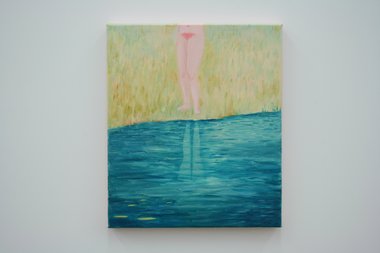
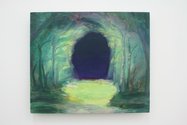
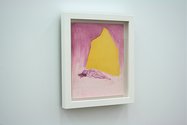
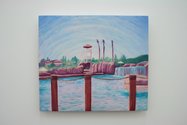
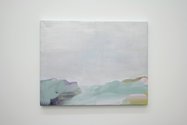
 Advertising in this column
Advertising in this column Two Rooms presents a program of residencies and projects
Two Rooms presents a program of residencies and projects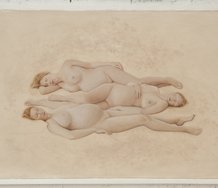
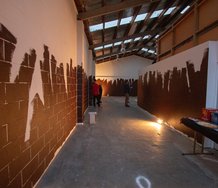
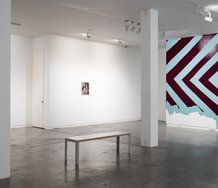
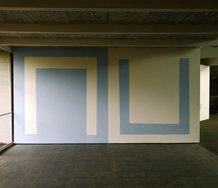
This Discussion has 0 comments.
Comment
Participate
Register to Participate.
Sign in
Sign in to an existing account.